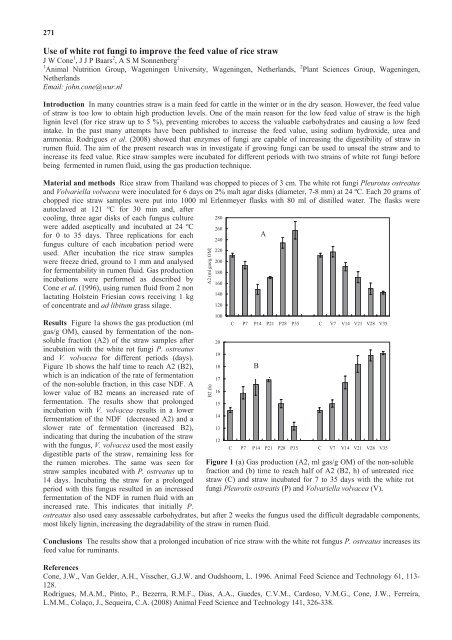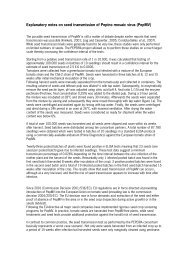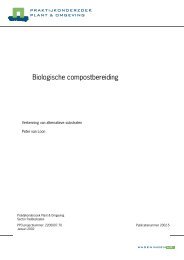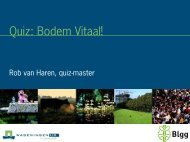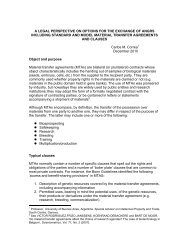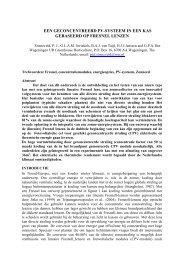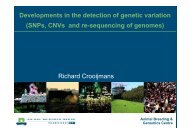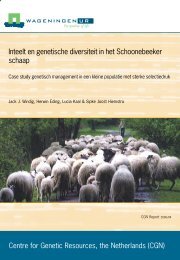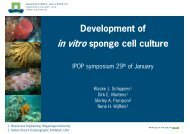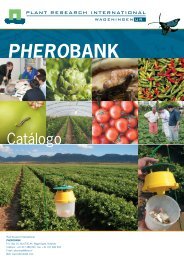Use of white rot fungi to improve the feed value of ... - Wageningen UR
Use of white rot fungi to improve the feed value of ... - Wageningen UR
Use of white rot fungi to improve the feed value of ... - Wageningen UR
Create successful ePaper yourself
Turn your PDF publications into a flip-book with our unique Google optimized e-Paper software.
271<strong>Use</strong> <strong>of</strong> <strong>white</strong> <strong>rot</strong> <strong>fungi</strong> <strong>to</strong> <strong>improve</strong> <strong>the</strong> <strong>feed</strong> <strong>value</strong> <strong>of</strong> rice strawJ W Cone 1 , J J P Baars 2 , A S M Sonnenberg 21 Animal Nutrition Group, <strong>Wageningen</strong> University, <strong>Wageningen</strong>, Ne<strong>the</strong>rlands, 2 Plant Sciences Group, <strong>Wageningen</strong>,Ne<strong>the</strong>rlandsEmail: john.cone@wur.nlIntroduction In many countries straw is a main <strong>feed</strong> for cattle in <strong>the</strong> winter or in <strong>the</strong> dry season. However, <strong>the</strong> <strong>feed</strong> <strong>value</strong><strong>of</strong> straw is <strong>to</strong>o low <strong>to</strong> obtain high production levels. One <strong>of</strong> <strong>the</strong> main reason for <strong>the</strong> low <strong>feed</strong> <strong>value</strong> <strong>of</strong> straw is <strong>the</strong> highlignin level (for rice straw up <strong>to</strong> 5 %), preventing microbes <strong>to</strong> access <strong>the</strong> valuable carbohydrates and causing a low <strong>feed</strong>intake. In <strong>the</strong> past many attempts have been published <strong>to</strong> increase <strong>the</strong> <strong>feed</strong> <strong>value</strong>, using sodium hydroxide, urea andammonia. Rodrigues et al. (2008) showed that enzymes <strong>of</strong> <strong>fungi</strong> are capable <strong>of</strong> increasing <strong>the</strong> digestibility <strong>of</strong> straw inrumen fluid. The aim <strong>of</strong> <strong>the</strong> present research was in investigate if growing <strong>fungi</strong> can be used <strong>to</strong> unseal <strong>the</strong> straw and <strong>to</strong>increase its <strong>feed</strong> <strong>value</strong>. Rice straw samples were incubated for different periods with two strains <strong>of</strong> <strong>white</strong> <strong>rot</strong> <strong>fungi</strong> beforebeing fermented in rumen fluid, using <strong>the</strong> gas production technique.Material and methods Rice straw from Thailand was chopped <strong>to</strong> pieces <strong>of</strong> 3 cm. The <strong>white</strong> <strong>rot</strong> <strong>fungi</strong> Pleu<strong>rot</strong>us ostreatusand Volvariella volvacea were inoculated for 6 days on 2% malt agar disks (diameter, 7-8 mm) at 24 ºC. Each 20 grams <strong>of</strong>chopped rice straw samples were put in<strong>to</strong> 1000 ml Erlenmeyer flasks with 80 ml <strong>of</strong> distilled water. The flasks wereau<strong>to</strong>claved at 121 ºC for 30 min and, aftercooling, three agar disks <strong>of</strong> each fungus culture 280were added aseptically and incubated at 24 ºC 260for 0 <strong>to</strong> 35 days. Three replications for eachA240fungus culture <strong>of</strong> each incubation period were220used. After incubation <strong>the</strong> rice straw sampleswere freeze dried, ground <strong>to</strong> 1 mm and analysed 200for fermentability in rumen fluid. Gas production 180incubations were performed as described by160Cone et al. (1996), using rumen fluid from 2 non140lactating Holstein Friesian cows receiving 1 kg<strong>of</strong> concentrate and ad libitum grass silage.120Results Figure 1a shows <strong>the</strong> gas production (mlgas/g OM), caused by fermentation <strong>of</strong> <strong>the</strong> nonsolublefraction (A2) <strong>of</strong> <strong>the</strong> straw samples afterincubation with <strong>the</strong> <strong>white</strong> <strong>rot</strong> <strong>fungi</strong> P. ostreatusand V. volvacea for different periods (days).Figure 1b shows <strong>the</strong> half time <strong>to</strong> reach A2 (B2),which is an indication <strong>of</strong> <strong>the</strong> rate <strong>of</strong> fermentation<strong>of</strong> <strong>the</strong> non-soluble fraction, in this case NDF. Alower <strong>value</strong> <strong>of</strong> B2 means an increased rate <strong>of</strong>fermentation. The results show that prolongedincubation with V. volvacea results in a lowerfermentation <strong>of</strong> <strong>the</strong> NDF (decreased A2) and aslower rate <strong>of</strong> fermentation (increased B2),indicating that during <strong>the</strong> incubation <strong>of</strong> <strong>the</strong> strawwith <strong>the</strong> fungus, V. volvacea used <strong>the</strong> most easilydigestible parts <strong>of</strong> <strong>the</strong> straw, remaining less for<strong>the</strong> rumen microbes. The same was seen forstraw samples incubated with P. ostreatus up <strong>to</strong>14 days. Incubating <strong>the</strong> straw for a prolongedperiod with this fungus resulted in an increasedfermentation <strong>of</strong> <strong>the</strong> NDF in rumen fluid with anincreased rate. This indicates that initially P.A2 (ml gas/g OM)B2 (h)100201918171615141312C P7 P14 P21 P28 P35 C V7 V14 V21 V28 V35C P7 P14 P21 P28 P35 C V7 V14 V21 V28 V35Figure 1 (a) Gas production (A2, ml gas/g OM) <strong>of</strong> <strong>the</strong> non-solublefraction and (b) time <strong>to</strong> reach half <strong>of</strong> A2 (B2, h) <strong>of</strong> untreated ricestraw (C) and straw incubated for 7 <strong>to</strong> 35 days with <strong>the</strong> <strong>white</strong> <strong>rot</strong><strong>fungi</strong> Pleu<strong>rot</strong>is ostreatis (P) and Volvariella volvacea (V).ostreatus also used easy assessable carbohydrates, but after 2 weeks <strong>the</strong> fungus used <strong>the</strong> difficult degradable components,most likely lignin, increasing <strong>the</strong> degradability <strong>of</strong> <strong>the</strong> straw in rumen fluid.Conclusions The results show that a prolonged incubation <strong>of</strong> rice straw with <strong>the</strong> <strong>white</strong> <strong>rot</strong> fungus P. ostreatus increases its<strong>feed</strong> <strong>value</strong> for ruminants.ReferencesCone, J.W., Van Gelder, A.H., Visscher, G.J.W. and Oudshoorn, L. 1996. Animal Feed Science and Technology 61, 113-128.Rodrigues, M.A.M., Pin<strong>to</strong>, P., Bezerra, R.M.F., Dias, A.A., Guedes, C.V.M., Cardoso, V.M.G., Cone, J.W., Ferreira,L.M.M., Colaço, J., Sequeira, C.A. (2008) Animal Feed Science and Technology 141, 326-338.B
Proceedings<strong>of</strong> <strong>the</strong> British Society <strong>of</strong> Animal Scienceand <strong>the</strong> Agricultural Research Forum2010Advances in Animal BiosciencesThis book is part <strong>of</strong> a series which is a companion <strong>to</strong> <strong>the</strong> journal ANIMAL
The Proceedings <strong>of</strong> <strong>the</strong> British Society <strong>of</strong> Animal Scienceconstitute summaries <strong>of</strong> papers presented at <strong>the</strong> Society'sAnnual Conference in Belfast, UK, 12-14 April 2010.The meeting was organised jointly with <strong>the</strong> AgriculturalResearch Forum whose papers are incorporated.The summaries have been edited. Views expressed in allcontributions are those <strong>of</strong> <strong>the</strong> authors and not those <strong>of</strong><strong>the</strong> British Society <strong>of</strong> Animal Science or <strong>the</strong> AgriculturalResearch Forum.This publication contains all <strong>the</strong> summaries that wereavailable at <strong>the</strong> time <strong>of</strong> going <strong>to</strong> press.Edi<strong>to</strong>rsS AthanasiadouE M BaxterD P BerryD Bol<strong>to</strong>nA F CarsonM A CroweL DawsonM G DiskinP D ForristalC E HaleJ P HanrahanM HazzledineL HeasmanN M HoldenD A KennyR W MayesT McCabeA P MoloneyD M NashP O’KielyK G RichardsR I RichardsonJ A RookeM RoseC RymerM A SteeleE WallM WallaceB T WolfB Younge© 2010 British Society <strong>of</strong> Animal ScienceISBN 978-0-906562-67-3ISSN 2040-4700


